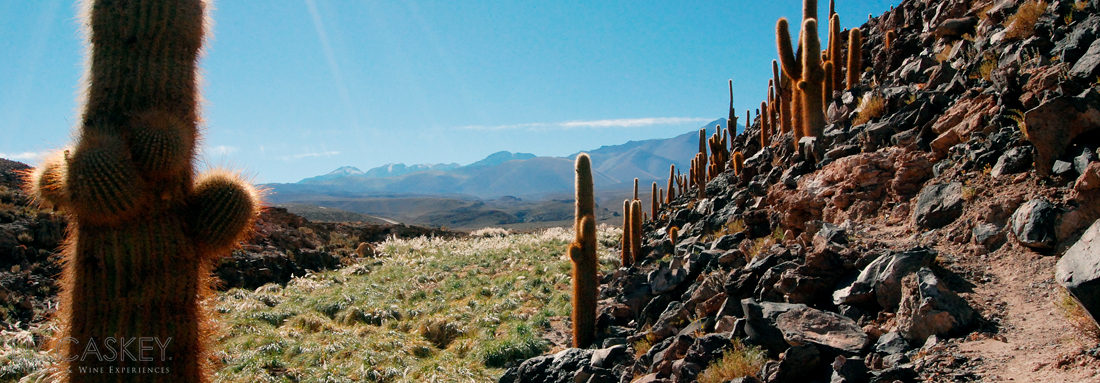
The Story, The basic story is one repeated time and again in South America: French know-how plus Chilean terroir equals outstanding wines—or in the case of El Principal winery, that is how the story originally started, but from their it morphed into its own.
The late Frenchman Jean-Paul Valette (former owner of Chateau Pavie in Saint-Emilion) came to Chile and fell in love with land, the people, and saw the potential to make incredible wines here. His ties led to a friendship and partnership with the Chilean Jorge Fontaine, the owner of Hacienda El Principal located in the far eastern part of Pirque (High Maipo Valley). Here they selected the best terroir and later planted and developed the existing vines, around 54 hectares of Cabernet Sauvignon, Merlot, the ubiquitous Carmenere and Cabernet Franc.
From this partnership El Principal S.A. was born, focusing exclusively, like most French chateaus, on only making the best quality wines. They planted Bordeaux-style (high density) for three years and in a tragic twist of fate, Jean-Paul died shortly before the 1999 harvest (one of Chile’s finest). However, given the Valette family’s devotion to wine (and Bordelaise history), his son Patrick Valette (now a very prestigious wine consultant in Chile), continued his father’s work. The key to their success? Make these wines like the great ones in France, both in technique and style.
The Valette and Fontaine families recently dissolved the society, selling to Döhle Latinamerika, the new German parent company. Despite the acquisition, the focus has not wandered—in fact, El Principal now has the financing to expand its vineyard plantings, acquire new (and better) equipment, more French barrels, etc. etc. Its long term goal of producing one of the finest “New World” wines grows stronger. And after our visit on a rainy Monday, we definitely believe it!
The Wines: Love at First Sight—and Sip
We arrived at El Principal around noon with gray clouds hugging the Andes foothills and a steady drizzle of rain. The main road and entrance to the hard-to-find winery was closed due to work on the road. However, after some meandering we found a caretaker who opened the secondary gate, making our way through a muddy “trail” back to the hacienda-cum-winery.
“Maestros”, or Chilean handy men, we pounding away at various projects by mandate of the new owner. We met with the current winemaker, Gonzalo Guzmán, a young, enthusiastic Chilean in a bare bones meeting room with a large wooden dining table and worn leather chairs. As in all of Chile at this time of year, there was a space heater to take the chill off. The entire back of the room was paneled in plate glass—and with good reason—the view of the Andes foothills, the vineyards, and terraces could be viewed in their emerald green splendor. The hills looked soft, like covered with evergreen plush velvet and the mistiness of the clouds shrouding the hills, gave it a mysterious, enchanting look.
Well, on to the wines. I will cut to the chase here! They were served a little cold given the day and the temperature of the cellar. Gonzalo decanted both of them and with the little space heater, they slowly came up to their ideal temperature (16 C).
To give you a little background on the wines, for those of you (like myself) always craving to know how they get to their final product. The vines are planted on the piedmont of the Andes on alluvial soils facing North (which is necessary in the Southern hemisphere for sufficient sun exposure and ripening). In order to get the tremendous concentrations El Principal is known for their vineyard management techniques includes shoot thinning, a green harvest, canopy management, crop thinning, hand-picking and table grape sorting before crushing. Their miniscule yield (of 4,000 /hectare) is strictly controlled in order to achieve fruit’s balance and the perfect ripeness.
In the winery, all the grapes are hand-picked and the berries hand-selected for quality before going into the tanks for crushing. A pre-fermentative maceration is done at low temperatures (8 C) for about 4 days in order to maintain the aromas (hence the fresh fruit nose you will find in these wines). After, the alcoholic fermentation is carried out at standard controlled temperatures. Other macerations during fermentation and post-fermentation last approximately 21 days. All the malolactic fermentation is carried out in new French oak barrels (100%), with aging continuing for 16 months. Batonnage (stirring of the wine gently in the barrels) is conducted every week during the first 6 months. To get to market is easily 3-4 years, like most premium wines in Chile nowadays.
Tasting Notes:
El Principal 2001: The fruit rules here—and when I say fruit think of walking through a farmers market munching on fresh black plums and black currants—no jams or canned fruit in sight! It is alive and kicking, as is its vibrating acidity, and assertive yet not overpowering tannins that give the wine great structure. Everything is so well integrated that the overall effect in the palate is freshness and elegance, renewed with each sip with its tingling acidity (making the bottle disappear unfortunately way too quickly).
Given this an extremely concentrated wine, the 2001 is almost on the border of being too young to drink. The best bet (and what we ultimately decided to do) was to buy a case and see how the wine evolves.
My response upon asking the winemaker what made this wine so incredible was, “Obviously great vineyard management…but honestly, it’s the terroir”. There you go.
Memorias 2000: Very similar to El Principal but less “charged” in terms of concentration and length. Made from the same grapes, the same style, the same vineyards, just less extracted and concentrated so simplicity and balance are the name of the game. Perhaps after trying El Principal this may seem like the “little brother” being less impressive and dramatic but it still maintains that editorial line of elegance, which for me is what characterizes these wines. A wine that could be ready to drink now; or at least in the short-to-medium term—but for El Principal this could still mean up to 5 years. So once again, buy a case and settle in to see what happens.
Production and Where to Find
1999: 3000 cases
2000: 2000 cases
2001: 4800 cases
As you can see, production is very limited and within Chile only to retail shops and very fine restaurants. Your best bet is to call the winery directly and order a couple cases: www.elprincipal.cl
This is one of Chile’s reference wines, specifically if you are interested in knowing what the potential is of Chilean soils and in particular, High Maipo Valley Cabernet-Carmenere. Absolutely inspiring.












